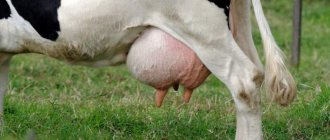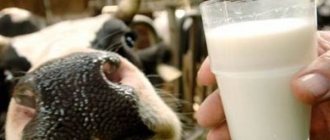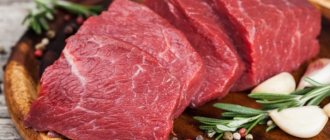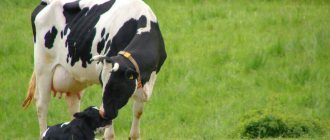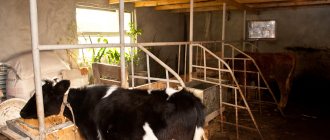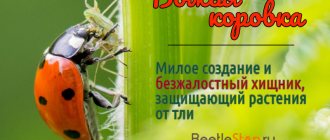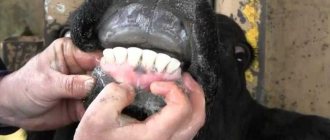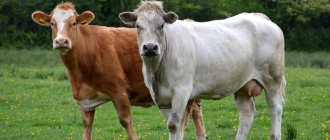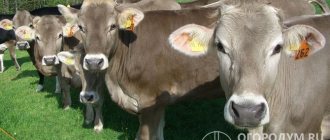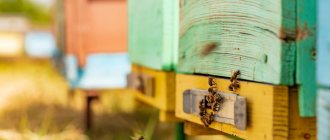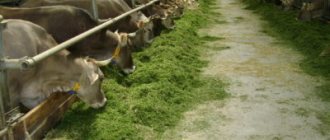In order to properly prepare a cow for calving and start her dry on time, it is necessary to be able to predict the date of birth of the calf. Sexual maturity in females begins to appear at 7-8 months. The time of first mating or artificial insemination depends on the breed of cattle.
Early maturing individuals quickly gain weight, their reproductive organs form early and hunting begins. They are ready for mating at 14-16 months. In late-ripening cows, weight can increase quickly, but the reproductive organs are formed closer to 2 years. Meat breeds are most often characterized by late ripening.
Females are taken to their first mating at 22 months. After mating, it is important to determine the female’s pregnancy. This is necessary in order to predict calving time. The first signs of pregnancy are not visible from the first months. The belly begins to increase only by the 5th month of pregnancy.
Pregnancy tests can be wrong. However, veterinarians do create pregnancy charts. They indicate the dates of mating and expected calving. How to schedule the calving of cows correctly? What needs to be taken into account?
Nutrition before calving
The period 2 weeks before calving requires a special approach. The cow should receive only high-quality cereal hay at this time. Everything else should be excluded, especially those foods that introduce excess fluid into the body. Three meals a day are maintained. A serving of food is approximately 10 kg, maybe a little less. It is recommended to water the cow during this period with clean water at a temperature of 8 to 10 degrees.
By the time of calving, the cow will gain up to 50 kg of weight - she looks plump, her udder is greatly enlarged. About a week before calving, secretions begin to be released from the udder.
Possible deviations from normal values
Indicators for the service period of cows are determined based on standards. However, in practice, all these values may deviate slightly from the required indicators. It is recommended to increase the dry period for young heifers and highly productive females. Such manipulations will help the body quickly recover and maintain its reproductive function throughout its life.
Most farmers prefer to shorten the service period. Their choice is based on a regular increase in offspring. However, they do not take into account the general condition of the female at the time of lactation and gestation. Many animals become completely infertile. Such changes are directly related to the lack of nutrients and minerals in the body.
To quickly replenish vital components during the cow's service period, it is recommended to use liquid energy feed. They contain balanced components of microelements and vitamins.
How to determine launch and calving dates
A cow's sexual cycle lasts about three weeks. It includes the period of estrus, sexual heat and ovulation. If insemination occurs during ovulation, pregnancy occurs. On average, pregnancy in heifers lasts about 285 days. In rare cases, deviations are possible (from 270 to 300 days). It all depends on the breed of the animal, nutrition, age and sex of the future calf.
Having established the fact that a cow is pregnant, you immediately need to determine the start time. Since only the fact of insemination is known, and most modern breeds give birth at the 9th month of pregnancy, experts advise starting the breeding 7.5 months after mating.
Sometimes, regardless of pregnancy, a cow may self-start. This is caused by disease, improper milking or feeding.
During pregnancy, the animal must be well fed, and in the second half of the period, the volume of feed must be increased by 0.3 feed units. In the fifth month, the animal’s overall milk yield decreases and it is gradually necessary to transfer it to dry milk. If milk yield does not exceed 4 liters of milk, milking should be stopped immediately. For cows with high productivity, the number of milkings is reduced to two per day, then to one and stopped when the productivity is 1 liter at a time.
There are two ways to determine the launch date of a heifer. The first one is based on a simple formula:
D = (H + 11)/(N - 3)
D here is the approximate month and day of calving; H – date of mating month; N – serial number of the month of mating; 11 and 3 are constant numbers
Important: if mating occurred in the first two months of the year, “12” is added to the serial number of the month.
That is, if the cow died on May 15, then using the formula (15+11)/(5-3) it turns out to be 26/2. This means the calf will be born around February 26th.
There is a more convenient way - a calving calendar. Consists of two dates – mating and calving. It allows a deviation of 10 days, which is considered normal.
Approximately 70 days before the expected calving, the cow is started (transferred to dry land). Her body needs to rest before giving birth and replenish its supply of nutrients and minerals. Note that the fetus gains weight most intensively in the last third of pregnancy.
Depending on the productivity of the animal, the launch is carried out gradually, over several days. At this time, you cannot massage the udder and feed the heifer with green grass and concentrates. The time spent on pasture is slowly reduced. As a last resort, it is permissible to feed the cow hay. When the udder is no longer filled with milk, the diet can be returned to normal volume.
During the dry period in summer, farmers recommend keeping the heifer grazing for a significant part of the day, but without long hauls. In winter, pregnant animals are released into the pen for 3-4 hours.
By the time of calving, a normal heifer should gain approximately 50 kg in weight and be well-fed. To complete the pregnancy period, the cow should stop lactation, since simultaneously carrying a calf and producing milk negatively affects calving. When started correctly, the animal's udder becomes dry and drops significantly (until folds appear).
In accordance with the calendar, the cow must be closely monitored in the last two weeks before the expected due date. The udder increases significantly, and the belly is retracted. About 7 days before calving, the ligaments at the root of the tail and pelvis relax, become pliable, and a secretion similar to sugar syrup is milked from the udder. Within a day, colostrum flows to the udder nipples and the animal becomes restless.
Below is a table that determines calving time.
| Mating time | Calving time | Mating time | Calving time | ||||
| month | number | month | number | month | number | month | number |
| January — — — February — March — — April — — May — — — June — — | 1 11 21 31 10 20 2 12 22 1 11 21 1 11 21 31 10 20 30 | October — November — — December — — — January — — February — March — — — April | 12 22 1 11 21 1 11 21 31 10 20 30 9 19 1 11 21 31 10 | July — — August — — September — — October — — November — — December — — | 5 15 25 4 14 24 3 13 23 3 13 23 2 12 22 2 12 22 | April — May — — June — — July — — August — — September — — October | 15 25 5 15 25 4 14 24 4 14 24 3 13 23 2 12 22 2 |
Signs of heat in females
A cow's readiness for mating can be determined by a number of characteristic signs and the condition of the genital organs, which manifest themselves during the process of sexual heat. A standard cycle lasts 21 days, a shortened cycle lasts half a month, and an extended cycle lasts 24 days. There are 3 stages:
1. Excitement
Signs of heat in a cow also manifest themselves in changes in its behavior:
- the level of anxiety and physical activity increases;
- loss of appetite;
- attacks of freezing when a male approaches.
Signs of heat
2. Inhibition and stabilization
During one of these stages, the follicular membrane ruptures, after which the egg is released. The duration of the period is on average 20 hours. The process is accompanied by the acquisition of a more saturated shade by the genitals.
Timing nuances
Sexual heat in cows does not always end with mating with a bull. During the first heat, heifers and recently calved females are not subject to mating. A cow is considered ready for mating at the age of 2-3 years, whose weight is 70% of the total weight of an adult. Until this age, active formation of the animal’s body occurs. The ideal mating time is considered to be the period from May to June inclusive, which will allow the female to stock up on a sufficient amount of vitamins and beneficial microelements before the onset of winter. In this case, calves should be expected in March of next year.
Duration of the hunt
Sexual heat in cows is a state in which they are ready to mate with a bull. On average, this period lasts about 18 hours, which is determined by the breed and age characteristics of the individual. Sometimes the duration of the hunt is influenced by the time of year. For example, in winter it lasts longer than in summer.
Duration of heat in cows
Farmers with extensive experience advise insemination in the middle of the cow's estrus period. It is this period that ideally coincides with the most active point of hunting, when there is a sharp increase in estrogen levels and a decrease in progesterone. After 10-18 hours, ovulation occurs.
Cow calving schedule: how to calculate the appearance of calves
In order to properly prepare a cow for calving and start her dry on time, it is necessary to be able to predict the date of birth of the calf. Sexual maturity in females begins to appear at 7-8 months. The time of first mating or artificial insemination depends on the breed of cattle.
Loading …
Early maturing individuals quickly gain weight, their reproductive organs form early and hunting begins. They are ready for mating at 14-16 months. In late-ripening cows, weight can increase quickly, but the reproductive organs are formed closer to 2 years. Meat breeds are most often characterized by late ripening.
Females are taken to their first mating at 22 months
After mating, it is important to determine the female’s pregnancy. This is necessary to predict calving time
The first signs of pregnancy are not visible from the first months. The belly begins to increase only by the 5th month of pregnancy.
Pregnancy tests can be wrong. However, veterinarians do create pregnancy charts. They indicate the dates of mating and expected calving. How to schedule the calving of cows correctly? What needs to be taken into account?
How to calculate calving time?
In the first month after mating, specialists conduct rapid pregnancy tests, take blood and milk tests for the presence of human chorionic gonadotropin, which is a pregnancy hormone. The main sign of pregnancy is the beginning of heat in cows. If after mating the animal does not show any desire, behaves calmly, and avoids other individuals in the herd, then pregnancy is noted.
The time of mating or insemination is recorded in a log. Pregnancy in cattle lasts 285 days. The expected calving date is calculated using the calendar. She is placed in a certain column of the calving table. This is one way to calculate the time of birth of a calf. The date may deviate from calculations by 5 days. This is the norm.
More on the topic: Is it possible to drink milk if a cow has mastitis?
Professionals have special tables. They already indicate the days of mating and calving. When carrying out mating, the veterinarian looks at the nearest day, which is indicated in the table. Using it, he can easily determine the time of appearance of the calf.
There are formulas for calving calving. D = (H+11)/(N-3), where
- D – date of birth of the calf;
- H – day of mating;
- N – number of the month in which mating occurred.
If mating occurred on May 1, then the calculation is performed: (1+11)/(5-3). D = 12/2, the calf will be born on February 12th. How to determine the day if insemination was carried out in March, because the month indicator will be “0”? carry out the calculation: (1+11)/(3-3) = 12/0. In this case, the calf can be expected on December 12th.
The name of the cow, its individual number are recorded in the log, the method of calculating calving is indicated, the date of insemination and forecast are recorded. Heifers may have a shorter gestation period. In an adult, the calf can stay in the womb for 5-7 days. This is not considered a pathology.
Rectal examination
A specialist can determine if a cow is pregnant at 30 days using palpation. They feel the walls of the uterus through the rectum. In its normal state, the uterus is small in size and fits in the palm of your hand. It is located in the pelvic floor. Its walls are dense, elastic, hard. A certain size of the uterus and horns, the filling of the blood vessels of the uterus, and the presence of a fertilized egg will indicate the development of pregnancy.
- A month after fertilization, palpation reveals changes in the uterine horn. He stops responding to touch. Normally it contracts. The ovaries become smaller and cannot be easily felt. Normally, they are located on both sides of the uterus, hard, the size of a chicken egg. The blood vessels of the uterine horn function normally.
- A month later, another study is carried out. Signs of pregnancy are already more clearly visible. The uterus is closer to the entrance to the pelvis, the horns of the uterus descend. One horn is enlarged to 6 cm: in normal condition its size is 3 cm. The amniotic sac is detected in it. On palpation, a sensation of fluid transfusion appears.
- At 3 months, the cervix is in the area of the pubic bones. The horn increases in diameter to 15 cm. Its walls become thin and loose. The floating fruit can be clearly felt.
- At 4 months, palpation of the uterus reveals the fetus and placenta. Its diameter is no more than 2 cm. Blood vessels differ in their filling capacity. They vibrate.
- At the 5th month, the cervix occupies most of the abdominal cavity, the size of the placenta is 4 cm. Owners of cattle during this period already know how to determine the pregnancy of a cow. The udder enlarges, the nipples swell, and the belly grows.
- By 6-7 months, the uterus descends even further into the abdominal cavity. It is not possible to palpate the fetus.
- At 8 months, the cervix is in the pelvic area. Upon palpation, body parts of the fetus are detected.
- By the 9th month, the placenta reaches a diameter of 8 cm. The fetus is in the pelvic cavity. Vibration of the blood vessels of the uterus is noted. The sacrosciatic ligaments are relaxed. Swelling of the lower abdominal wall and udder is observed.
Rectal examinations are carried out before morning feeding, before milking. Only a veterinarian can do it. Palpation of the uterus is carried out from the 4th month of pregnancy.
Diet depending on the characteristics of the breed
You need to select a balanced diet for a pregnant cow based on the type to which her breed belongs:
- Pregnant beef cows during pregnancy are fed cereal and legume hay, corn silage, and haylage with the addition of table salt. The menu of beef cows necessarily includes protein, starch, and mineral supplements (components such as zinc, copper, phosphorus and calcium are especially important).
- Dairy cows are given silage and hay, dry feed and silage. Dairy cows need even more protein and mineral components. The amount of water should be limited, its amount should not exceed 48 liters per day.
Both varieties are given pulp (sugar beet chaff), stillage (a substance, a product of processing wort) and yeast-based additives. In order for a pregnant cow’s diet to be truly balanced, a calendar is drawn up where the diet is scheduled depending on the period of pregnancy.
It is important to adhere to one rule here: food for a pregnant cow cannot be spoiled, rotten, or musty. This can cause miscarriage or premature birth. Some cow owners believe that reducing the amount of feed they feed makes calving easier.
All that can be achieved with this is the exhaustion of the cow and calf
Some cow owners believe that reducing the amount of feed they feed makes calving easier. All that can be achieved by this is the exhaustion of the cow and calf.
Cow insemination process
How are cows inseminated? Insemination of cows can occur in several ways. This can be free mating, an insemination bull, or artificial insemination with pre-collected ejaculate by a veterinarian.
With free mating, the bull is constantly in the herd of cows and covers as many individuals as he can. The disadvantage of this method is the inability to track which cows it covered.
Cow inseminator
How can you inseminate a cow? The use of insemination bulls will be called the natural method of producing offspring. To do this, you need to carefully select the male. A strong and healthy cow breeder should be checked for infectious diseases. This is an energy-consuming process, so the use of the bull should be limited during the breeding season. The maximum load per bull is 30-40 heifers per season. With more frequent use, the bull becomes exhausted. For older bulls, the load should be reduced.
The use of insemination bulls will be called a natural method of producing offspring
Mating of animals takes place in a separate arena equipped with a pen. In the pen, the bull's front legs do not rest on the cow, making the process easier. Mating should be repeated after 12-15 hours.
Artificial insemination of cows
Artificial insemination is a carefully planned event carried out under the supervision of a specialist. To do this, the ejaculate is collected in advance and tested for fertilizing ability in the laboratory.
In this way, maximum efficiency of fertilization of females is achieved. Compliance with the rules and standards of hygiene allows you to carry out the entire process safely. In addition, this way you can select and combine the characteristics of the parents that are necessary for the offspring.
Artificial insemination of cows
Insemination of cows using the rectocervical method
The advantage of the method is the accuracy of correct entry into the cervical canal of the uterus, thanks to fixation through the anus.
Important information! Carrying out a cervical massage can enhance the suction ability of the organ.
For manipulations you need:
- disposable syringes 2 ml;
- polyethylene ampoules 48 mm;
- polystyrene catheters 35-42 cm;
- disposable gloves 80-90 cm.
The manipulation scheme is as follows. Before completely removing the catheter from the package, it should be tightly connected to the syringe or ampoule using a coupling. After this, it can be completely removed. Using an ampoule or syringe, draw sperm (1-1.2 ml) into the catheter from a previously prepared bottle.
Important! Before the procedure, sperm activity should be examined under a microscope. After fixing the animal, treat the external genitalia with a disinfectant solution.
By spreading the labia with a gloved hand, you need to insert the catheter without touching them into the vagina. The limiter at this moment is the connection point with the syringe. To avoid getting the catheter into the urinary canal, insert it from below 15 cm, then pull it upward at an angle of 20-30° and horizontally to the end
After fixing the animal, treat the external genitalia with a disinfectant solution. By spreading the labia with a gloved hand, you need to insert the catheter without touching them into the vagina. The limiter at this moment is the connection point with the syringe. To avoid the catheter getting into the urinary canal, it should be inserted from below 15 cm, then pulled upward at an angle of 20-30° and horizontally to the end.
Wet your hand in warm water or saline and insert it into the anus. This position will allow you to control the process of moving the catheter through the vagina. If it gets stuck in the vaginal fold, you can move the uterus away by straightening the vaginal wall.
Fix the cervix with your hand so that you can guide the movement of the catheter with your fingers. As the catheter enters the uterus, movements should be made to pull the cervix onto the catheter.
Insemination of cows using the rectocervical method
When the catheter passes 6-10 cm, the sperm should be carefully introduced. The maximum effect can be achieved when the cervical canal passes completely and the sperm enters the uterine cavity.
After the procedures, the hand must be removed from the rectum. Disconnect the syringe from the catheter by slowly pulling it out of the vagina.
Methods for determining pregnancy
There are several ways to find out if a heifer is pregnant. This can be done at home without any medical equipment, for example, milk. The behavior of the animal also helps to identify changes that have occurred in its body. What methods are used to detect pregnancy in cattle:
- Lab tests.
- Ultrasonography.
- Rectal examination.
- Hormonal tests.
- Visual inspection of the animal.
Most methods for determining pregnancy are within the competence of the veterinarian. A farmer can independently find out about a cow’s pregnancy in only two ways - by observing her behavior and by testing milk.
Rectal examination
A rectal examination of cows for pregnancy is carried out by a veterinarian, since he knows what changes the uterus in animals undergoes after fertilization. The doctor has extensive experience and will not harm the cow during the examination.
The veterinarian treats his hands with disinfectant solutions and puts on high sterile gloves. His assistant fixes the cow's horns. At this time, the veterinary service worker moves the animal’s tail to the side and carefully inserts the brush into the anus.
A rectal examination can determine:
- change in the size of the uterus,
- study the shape of the reproductive organ;
- wall consistency;
- density;
- location in the peritoneum;
- condition of the ovaries;
- palpate the corpus luteum (in the early stages of pregnancy);
- examine the cervix.
The veterinarian is able to accurately determine pregnancy at the earliest stages, in the first month after fertilization.
Attention! When performing a rectal examination of a cow, you should be extremely careful not to provoke an increase in uterine tone and not to cause injury to the animal. At the moment of muscle contraction, you should stop moving your hand to avoid internal tears.
For milk
Most farmers know how to determine if a cow is pregnant by looking at her milk. Its chemical composition and quality indicators tend to change when a cow becomes pregnant. A drop of milk can easily determine whether fertilization has occurred. Let's look at two ways to do this at home.
- Fill a glass with clean, cool water and place a drop of freshly expressed milk on its surface. Watch her - if the droplet completely dissolves without leaving a white trace, then the cow is not pregnant. Otherwise, the drop will leave a blurred spot on the surface of the water, resembling a cloud.
- Mix an equal amount of alcohol and fresh milk from the cow being tested and wait a few minutes. If the cow is pregnant, the milk will curdle.
Ultrasound examination is allowed to be performed 30 days after the expected date of fertilization. The ultrasound scan is performed by a veterinarian. Using a sensor on the monitor screen, you can see not only the embryo, but also identify possible pathologies of its development.
Attention! Ultrasound diagnosis too early can cause miscarriage
Laboratory diagnostics
Based on the results of laboratory tests, it is easy to determine the pregnancy of a cow. Under the influence of changes in the animal's hormonal levels, the chemical composition of the blood also changes. Reliable data on a cow’s pregnancy can be obtained already in the third week after fertilization (provided that more than three months have already passed since the last pregnancy).
Pregnancy tests
Pregnancy test for cows using milk
There are two types of pregnancy tests for cows. Both respond to an increase in the animal's progesterone levels, a hormone that is actively synthesized during pregnancy. One of the tests is designed to analyze milk, the other determines pregnancy using urine.
Visual inspection
Observing changes in the behavior and well-being of the animal makes it possible to determine pregnancy almost accurately
What to look for during inspection:
- The fertilized female becomes calmer, her movements are smoother.
- The wool becomes soft and shiny.
- Appetite improves.
- There are no signs of hunting.
- Within a month and a half after fertilization, a mucous secretion is released from the cow’s vagina. It is clearly visible on the external genitalia.
Closer to the 5th month of pregnancy, changes are visible to the naked eye. The cow's belly is significantly rounded, and on one side it sticks out more. Experienced farmers already have the opportunity to feel the fruit from the outside. It is best to do this early in the morning, when the cow has not yet eaten. It is enough to place your palm on the left side below the hungry hole to feel the calf inside. With characteristic tapping, the fetus may respond with jerks.
How to take care of a pregnant cow
During pregnancy, a cow needs special care. Let's consider how to feed the animal during this period, and how to care for a pregnant cow.
Nutrition
Cows need special nutrition during pregnancy. It is worth noting that by the end of pregnancy, the weight of a newborn sometimes reaches 20 kg.
A balanced diet for a pregnant cow allows you to get healthy offspring. The feed should contain large quantities of proteins and beneficial minerals. You should also remember about water. It is necessary to give the animal water 2-4 times a day.
If basic vitamins are not present in sufficient quantities in the food, this can cause the development of fetal pathologies, and sometimes even lead to miscarriage.
During stall housing, it is recommended to use forbs and silage to feed a pregnant cow. You should also not neglect high-quality feeds designed specifically to prepare the cow for pregnancy.
In winter, it is useful to add pine flour or spruce branches to the food of a pregnant cow. They contain vitamins necessary for the animal during preparation for calving. You should not feed your cow moldy hay or frozen vegetables.
Improper nutrition leads to a significant deterioration in the individual’s well-being and the taste of dairy products. This can be fatal both for the fetus and for the cow itself.
Vaccination
Immunization of pregnant cattle can be carried out up to 7 months of pregnancy. 3 months before the expected calving date, you should stop using any vaccine.
The exception is a drug that helps cope with anthrax. In addition, experts do not recommend donating blood for testing for leukemia. Since this can negatively affect the well-being of the expectant mother and fetus.
It is recommended to carry out vaccination prematurely, before the dry period begins. A separate immunization calendar should be maintained for each animal, and it must be strictly followed.
You should not risk the herd, especially when conception is expected. The FMD vaccine must also be given before 7 months of pregnancy. For this purpose, a lapinized cultured virus is used.
If it is possible to get vaccinated in advance, there is no need to wait for fertilization. The same applies to rabies vaccination.
Against the backdrop of an acute lack of vitamins, it is important to take appropriate measures in a timely manner. The best option is a balanced diet, but if a problem arises, you will have to resort to injections of vitamin complexes. This way you can save the life of a pregnant cow and fetus, improve their health and protect the upcoming birth.
This way you can save the life of a pregnant cow and fetus, improve their health and protect the upcoming birth.
Walks
An important component of proper care for a pregnant cow is walking. Due to the confinement of animals during pregnancy, the risk of developing pathologies increases, productivity decreases, and the likelihood of abnormalities developing in the unborn calf appears. To prevent such negative consequences, you need to set aside a place for the pregnant individual to walk, protecting it from drafts, the negative effects of sunlight and rain.
To prevent such negative consequences, you need to set aside a place for the pregnant individual to walk, protecting it from drafts, the negative effects of sunlight and rain.
The walking area for one cow must be at least 8 m2 in area.
When a cow's pregnancy reaches 6-9 months, you need to ensure that she walks carefully. The duration of walks should be reduced in winter. If it’s icy outside, it’s better to stop walking altogether, as this risks causing the cow to fall, which can lead to injury and even miscarriage.
If it’s icy outside, it’s better to stop walking altogether, as this risks causing the cow to fall, which can lead to injury and even miscarriage.
The duration of walks should be reduced in winter. If there is ice outside, it is better to stop walking altogether, as this risks causing the cow to fall, which can lead to injury and even miscarriage.
It is worth noting that pregnant cows must be walked separately from other cows in order to prevent possible injuries and spontaneous termination of pregnancy.
Possible complications or illnesses
If a cow is kept in poor conditions, is not monitored, and has poor nutrition, then diseases cannot be ruled out. Even those females who are protected from all troubles can catch the disease, but in the absence of care, the chance of a good birth is reduced several times.
If a cow begins to fall ill, it will be visible from her. The most common symptoms are bad stool, digestive problems, colic, wheezing, chills, and fever. If these symptoms appear, you should urgently call a veterinarian to understand how to treat the animal.
To prevent diseases, the wool is promptly treated to remove parasites. Worms are also driven out immediately after the news of pregnancy. To understand what vitamins and minerals the animal needs, tests are done and, if necessary, premixes prescribed by a veterinarian are added to the diet or beneficial substances are administered by injection. To strengthen well-being, improve immunity, and health, it is necessary to add the drug “Chiktonik”, “Serdimin” or similar to the food.
How many days does a cow walk before calving?
It is very important to know how long a cow’s pregnancy lasts. This will help to correctly calculate the beginning of the dry period and prepare the animal for the birth of a calf.
Fine
The duration of gestation of a calf depends on the characteristics of caring for the heifer, as well as genetic predisposition. Cows, like people, carry a fetus for an average of 9 months. Many livestock breeders take 283–285 days as the norm.
Did you know? To produce 1 liter of milk, about 400 liters of blood must pass through the udder. That is, to obtain 20 liters of daily milk yield, about 8000 liters of blood must pass through the udder of a cow!
How many can go
The above period is very average, and birth can occur either earlier or later than the due date. For example, with improper care and an inappropriate diet, a calf may be born several days or even weeks (up to a month) earlier. Likewise, a cow can carry a fetus. Taking these factors into account, a cow's pregnancy may fall within the range of 240–311 days.
This is interesting: How bulls are slaughtered: we tell you in detail
Stages of fetal development
Before you start creating a personal calendar, you should familiarize yourself with the stages of fetal development. The pregnancy itself is divided into several months.
For the first 30 days, the embryo can hardly be called a calf. At this moment, the formation of the organs of vision and part of the oral cavity occurs. You can see the gill slits and the vascular network that replaces the skin. The weight of the fetus at this moment is about 1 g.
At day 60, organs are formed that will subsequently control vital functions. The formation of the placenta begins along with the active growth of the embryo. Now the fruit reaches 8 cm and weighs up to 30 g.
Read also: Cow manure: how to use it as a fertilizer, rules for applying it to the soil
90-150 days: the formation of the reproductive system and the formation of horns begins. It is from this moment that the embryo becomes a calf. Its size is about 45 cm and its weight is about 4 kg.
From day 180, the fur on the limbs begins to grow; over the next 2 months, the fetus will be covered with short, smooth hairs. From day 210 until the birth process, the formation of internal organs and incisors occurs.
The average duration of pregnancy in cows lasts 285 days.
Calving date of a cow after insemination
In order to approximately find out the date of birth of the calf, you can calculate it using the following formula:
(Date of calving) = ((Day of month) + 11) / (Number of month – 3)
The following notation is used in the formula under consideration:
- calving date – on this day the calf is expected to be born;
- day of the month is the day of the month when fertilization occurred;
- the month number is equal to the serial number of the month from the beginning of the year (January corresponds to one, February to two, and so on).
Let's give an example of a calculation. Let's say a cow was inseminated on September 15th. In this case, the formula is applied as follows:
(Calving date) = (15 + 11) / (9 - 3) = 28 / 6
Using calculations using this formula, it was found that calving will occur approximately on June 28th.
Calving date of a cow after insemination
It is possible that the first amount will exceed the number of days of the month. In this case, the number must be reduced by the specified amount.
Example. If the number 25 and 11 are summed, the result will be 36. From it you need to subtract 30 (the number of days in a month) and write down the result of the subtraction.
The number of days in different months differs from each other, but we must not forget that this is an approximate, not an exact date.
Besides using the formula given here, there is another way. In this case, the calving calendar is used to determine the desired period.
False alarm
Symptoms indicating successful mating do not guarantee the animal’s pregnancy. After insemination, cows may bleed, which often indicates a false pregnancy.
Signs of pregnancy (full udder, enlarged uterine horn, discharge) can deceive livestock breeders. Various methods are used to accurately determine pregnancy. If the pregnancy turns out to be false, this indicates the following reasons:
- hormonal disruptions - a fertilized egg cannot take hold in the uterus;
- miscalculation of mating days - the egg does not undergo the fusion process due to lack of ovulation, while there are signs of calving;
- deviation of the endocrine glands - poor functioning of the thyroid gland with symptoms of erroneous postmaturity;
- low stability (emotions and work loads) - there is no standard production of enzymes.
The course of an imaginary pregnancy, when the embryo is resorbed, is similar to the real one. Only an experienced specialist and veterinary research will help put an end to it.
At the end of the false pregnancy, fluid comes out of the cow instead of a calf. A few hours later, farmers carefully begin milking.
Childbirth
Help at the hotel
During the period of expected birth, the cow is not allowed to go for walks. The first aid kit is stocked
- iodine,
- potassium permanganate,
- Vaseline,
- ichthyol ointment,
- cotton wool, bandages, soap.
In case of a difficult birth, you need to stock up on a strong rope of two to three meters.
Signs of the beginning of calving.
- Anxiety;
- Trampling;
- Moos;
- If he doesn’t find a place, he will lie down and then get up;
- Looks at his stomach.
If these signs are detected, the labia, legs, and tail are washed and wiped dry with a warm solution of potassium permanganate (ratio 1 l / 1 g).
Childbirth usually occurs without complications. But it is advisable for the cow to lie down on her left side. This will make it easier for her. If all is well, it will be over within an hour.
You can make sure that the birth is proceeding normally by how, after the rupture of the amniotic sac, the front legs of the calf appear, and the head appears on them. This position of the fetus is considered correct. But it may turn out that the attempts are weak and the cow cannot give birth. Then she needs help. In this case, resort to using a rope. It is tied to the front legs of the calf and pulled synchronously with the cow's efforts. In more complex cases, you need to contact a veterinarian.
A newborn calf's mouth and nostrils are cleared of mucus. The site where the umbilical cord is cut is cauterized with iodine. The cow needs to lick the calf. She will use her rough tongue to clean the calf of mucus and at the same time massage it, which will help stimulate blood circulation.
Cow licks calf
After calving, the cow is given warm water in which salt is diluted in a ratio of 120 grams per bucket of water. After an hour and a half, she needs to be milked. The first jets are drained. They should not be given to a calf. The rest of the milked colostrum should be fed to the calf.
Within six hours, during normal labor, the placenta should pass. If he doesn't come out within a day, you need to contact a veterinarian.
During the first days after childbirth, pay special attention to the udder. Drink often to avoid mastitis. If all is well, then after a few days it can be sent out to pasture.
General Tips
- It is recommended to draw up an individual calving calendar for a cow, taking into account the characteristics of a particular animal. This table is the most accurate.
- The firstborn should not be released to pasture if even slight signs of impending calving appear.
- The cow should not be stressed before calving. Daily inspection of the cow at the end of pregnancy will help determine that the cow is about to give birth.
- The time of the onset of contractions in a cow must be recorded for an accurate idea of the duration of the labor process.
- If a cow has multiple pregnancies, the animal's condition must be monitored by a veterinarian.
Care and feeding
A pregnant cow requires a lot of attention. It must be kept warm, in a clean stall, where there is no dampness or draft. During the dry period, the animal needs daily hygiene - the skin should be brushed and the udder should be washed with warm water.
It is important to keep the litter clean. During pregnancy, the cow should walk a lot - if possible 2-3 times a day for an hour. This will avoid complications after childbirth such as udder swelling and other pathologies.
This will avoid complications after childbirth in the form of udder swelling and other pathologies.
The diet of a pregnant cow during the dry period should include:
- Good quality meadow hay.
- Root vegetables - carrots, potatoes, beets.
- Juicy food.
- Concentrates.
- Vitamin supplements (chalk, salt).
Important! The quality of the food supply must be strictly controlled - it is unacceptable to give the animal rotten hay, rotten vegetables, or sour food. You cannot give a cow cold water - sometimes this leads to miscarriage. The health of the future offspring, as well as the productivity of the animal, depends on the timeliness and correctness of the start of the cow.
The ideal time to start transitioning to dry cows is 2 months before calving. If the cow's milk yield is large, over 10 liters of milk per day, the start should be started earlier - 60-75 days before giving birth. If lactation does not stop despite dietary restrictions and changes in the milking schedule, it is necessary to use medications to start the cow
The health of the future offspring, as well as the productivity of the animal, depends on the timeliness and correctness of the start of the cow. The ideal time to start transitioning to dry cows is 2 months before calving. If the cow's milk yield is large, over 10 liters of milk per day, the start should be started earlier - 60-75 days before giving birth. If lactation does not stop, despite dietary restrictions and changes in the milking schedule, it is necessary to use medications to start the cow.
To properly organize the start-up, dry-off and calving periods, the farmer needs to keep a calendar that marks the cow's mating time. This will help you accurately calculate all the required dates.
If calving occurs earlier or later than the expected date, this depends on the characteristics of the cow and is considered acceptable. Normally, resolution of the burden occurs on the 285th day. Taking into account possible deviations, it is believed that calving can occur in the period of 265–300 days.
The animal's rest period from lactation must be at least 60 days. During this period, it is necessary to carefully monitor the diet and maintain the necessary conditions in the room. It should be illuminated, and the litter should be kept dry and updated daily.
Diet
During the period of starting a cow before calving, the artiodactyl should gain 60-65 kg in weight. Hay is suitable for feeding in the initial period to prevent overeating. She is also given a small amount of water at this time.
It is better to feed a cow at startup after the udder has dried out with the following products:
- chalk;
- bran;
- salt;
- special feed for prenatal cattle.
A month before the end of the launch period, the diet should include:
- feed mixtures for calving cattle;
- crushed corn;
- pressed sunflower seeds;
- processed beets.
The starting time is selected for each cow individually. It is determined by the following factors.
- Estimated calving date. There are formulas and tables to determine or calculate it.
- The age of the cow. The first heifer should be stopped milking gradually over a longer period.
- Milk productivity. Cows that produce a lot of milk are started more slowly.
Based on the above factors, the optimal start-up or dry period would be:
- for first-calf heifers and cows of high milk productivity - three months;
- for animals with average milk production - two or two and a half months.
The minimum duration of the dry period can be forty days.
This is achieved in the following way:
- changing your diet;
- stopping milking;
- decreasing (if milk production does not stop) the amount of water;
- reducing grazing time (if the start occurs in the summer).
Use of colostrum
How is pregnancy determined in a cow at home?
Isolation takes only 5-10 days, which makes it a particularly valuable product. You can't get it at any time. Despite this, large farming enterprises have organized calving schedules in such a way that they supply large quantities of product regularly.
Large quantities of this product are most needed by the pharmaceutical industry. It is used for a number of drugs for the treatment and prevention of diseases of various origins:
- respiratory tract infections and diseases, including asthma;
- diseases of the gastrointestinal tract: ulcers, colitis, gastritis, pancreatitis;
- disorders of the musculoskeletal system: osteochondrosis, polyarthritis, rheumatoid arthritis;
- for nervous disorders: fatigue, depression and loss of vitality.
It is also widely used in the treatment of various autoimmune diseases.
A person can consume colostrum in its pure form. However, it has a rather specific taste, smell and texture, so few people like it. The appearance of cow colostrum is shown in the photo.
To obtain all the beneficial components contained in it, many people prefer the colostrum supplement, which is made from it. This supplement is used in the following dosage:
- infants 6-12 months - 10 g morning and evening;
- children 1-3 years old - 10-15 g twice a day;
- older children and adults – 15 g twice a day.
Cows’ “first milk” is also actively used in cooking. The most popular dish made from “first milk” is considered to be a casserole in the oven with the addition of sugar and eggs.
Attention! Due to the chemical composition, texture and properties of cow colostrum, fermented milk products, butter and cheese are not made from it.
What to do after?
After calving, special attention should be paid to both the mother and the calf. After giving birth, the back of the cow, as well as its belly and genitals, should be soaped with laundry soap.
Then you need to rinse it off with warm water and wipe with a dry and clean towel. After 25 minutes, the cow should be given one bucket of water, and be sure to drink it warm. After 35 minutes the placenta should come out
After giving birth, the rear part of the cow, as well as its belly and genitals, should be soaped with laundry soap. Then you need to rinse it off with warm water and wipe with a dry and clean towel. After 25 minutes, the cow should be given one bucket of water, and be sure to drink it warm. After 35 minutes, the placenta should come out.
If the cow that will calve has health problems, then calving should only take place under the strict supervision of a doctor. In addition, the veterinarian must fill out a special calving calendar and give the cow a rest. Then you need to periodically monitor the condition of both the cow and the calf. In addition, to restore strength, you can give the cow an energy drink - this is a slightly salted aqueous solution.
As soon as the afterbirth comes out, it is necessary to change the bedding to fresh one, and also carry out the first milking. Before this, the udder must be thoroughly washed and wiped dry. The first to come is colostrum, which needs to be fed to the little calf. After this, it is imperative to milk the animal, especially for firstborns. This will allow the cow to produce a little more milk in the future.
When milking for the first time, it is very important not to damage the cow’s udder, so you must first massage not only the udder, but also the nipples. After milking it must be repeated
It is also necessary to rinse it and wipe it dry.
Don’t forget about the cow’s diet. Nutrition must be balanced and rich in vitamins.
First you need to give her silage and hay to start lactation. On the second day, you can add 1 kilogram of rice or bran to the diet, pre-soaked in water for a while. Further, their quantity can be increased to 2 kilograms. Already from the third day, you can try to introduce some root vegetables into the cow’s diet to increase lactation. After a week, the cow can be switched to complete food.
If an animal does not eat well after calving or has had a very difficult birth, then the feeding schedule must be coordinated with specialists. In addition, livestock farmers need to ensure that there is a sufficient amount of protein in the feed. Otherwise, the milk will be of poor quality.
A newborn calf must remove mucus from both its mouth and sinuses. This is done using a special pear. Next, you need to wipe his face and eyes with warm boiled water. Then you need to cut the umbilical cord 11 centimeters from the abdomen. After this, you need to squeeze out all the blood from it and treat the incision site with iodine.
If the calving went well and the cow has no complications, the calf can be brought to the cow. This is done so that she will lick it. After this, the baby’s health will improve significantly, and will also help the cow’s placenta come out faster.
Next, the calf must be transferred to a separate pen, where there must be appropriate bedding. Exactly one hour after calving, you can give him colostrum, since it is in the first hours that it is best absorbed by the body.
In 24 hours, the baby can approach the udder about 20 times. At the same time, he drinks in small portions. When drinking from a bucket, this can lead to bad consequences. After all, colostrum will fall on a scar that has not yet healed, which can cause it to rot. Therefore, if the calf is immediately separated from its mother, it is best to feed it from the nipple. You also need to make sure that the baby is gaining weight well, otherwise it is necessary to supplement him.
After 45-60 days after birth, calves need to receive special vaccinations. In addition to milk, the calf can gradually be fed with fresh hay, as well as beets or potatoes.
After a certain time, the volume of his food needs to be increased. Potatoes must be peeled.
Term
You can find out the exact date of birth of the calf, which is calculated using a special formula. To the day on which fertilization occurred, you need to add 11, for example (8+11). Next, you need to divide by the number of the month of fertilization minus 3, for example (4-3). Ideally, the formula will be (8+11) / (4-3), that is, 17 must be divided by 1. The result will be 17. This means that calving will occur on this number 9 months after fertilization.
To avoid using formulas, you can use the calving calendar, where all insemination dates are marked. This is the most accurate table, which has 4 columns. The first and third indicate the month and date of insemination, but the second and fourth indicate the month and date of calving, respectively.
However, it will not be possible to accurately determine the calving period using such a schedule; the error will be within 10 days. Therefore, you need to either apply a formula to more accurately calculate how long the pregnancy will last, or watch how the cow feels.
